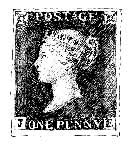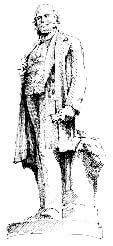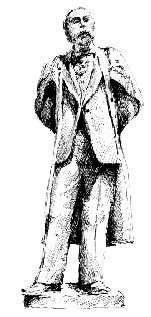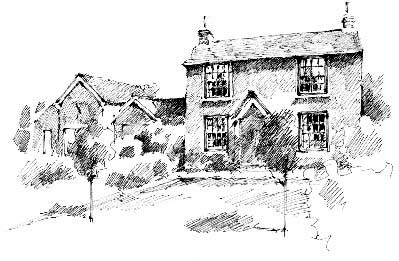Worcestershire
MUSIC ALL AROUND US ∗ BATTLE OF WORCESTER
∗ TRAIN SETS ∗ PUBS AND PUB SIGNS
Sir Edward Elgar, as English as the Malvern Hills that inspired his music.
WORCESTERSHIRE FOLK
Sir Rowland Hill ∗ King John ∗ A.E. Housman ∗ William Richard Morris ∗ Nigel Mansell
The Land of Heavenly Spring
Worcestershire’s own Prime Minister, Stanley Baldwin, described his home county as ‘The Land of Heavenly Spring’. Worcestershire is England’s orchard, one of the most English of counties, quiet, beautiful and unassuming. Worcestershire has England’s oldest hills, the Malverns, with bubbling spring water fit for a queen. It has the Vale of Evesham, ripe with plums, apples, pears and currants for the fruit baskets of England. Its cricket ground boasts the most perfect setting in English county cricket, set on the River Severn and watched over by King John from Worcester’s medieval cathedral.
Sir Edward Elgar
1857–1934
‘There is music in the air, music all around us . . .’
There is certainly music in the Worcestershire air, for it is the fields and hills of this mellow English county that gave birth and inspiration to that most English of composers SIR EDWARD ELGAR.
Elgar was born in a humble brick cottage called The Firs in UPPER BROADHEATH, near Worcester, on 2 June 1857. His father owned a music shop in Worcester and, as a boy, Elgar would take manuscripts from the shop out into the countryside on his bicycle to study them, and so came to associate music with the scenery around him. He lived in Worcestershire until he was nearly 30, playing and teaching the violin, composing, cycling along the country lanes and wandering across the Malvern Hills. Perhaps this is why his music manages so powerfully to capture the essence of England and the English countryside.
Any film-maker who wants to establish an English setting will choose Elgar’s music for his soundtrack, for it is as iconic of England as a thatched cottage, a red telephone box, a cathedral, a Constable painting, a cricket match or a cream tea.
His music is associated with two great national occasions. ‘Land of Hope and Glory’, adapted from Pomp and Circumstance March No. 1, with words by A.C. Benson, was composed as a Coronation Ode for Edward VII. It is considered to be a National Anthem for the English and is sung lustily amidst much flag-waving at the Last Night of the Proms.
The performing of ‘Nimrod’, from Elgar’s Enigma Variations, by massed bands at the Cenotaph in London on Remembrance Sunday is often cited as one of the most moving moments of that reflective day, along with Laurence Binyon’s famous poem ‘For the Fallen’, which Elgar put to music in his Spirit of England.
The Dream of Gerontius, Elgar’s choral setting of Cardinal Newman’s poem about a man’s journey into the next world, resurrected the reputation of English choral music and established Elgar as England’s foremost composer.
On 12 November 1931, Sir Edward Elgar performed the opening ceremony at ENGLAND’S, AND THE WORLD’S, FIRST CUSTOM-BUILT RECORDING STUDIOS, THE ABBEY ROAD STUDIOS at St John’s Wood in London, conducting the London Symphony Orchestra in an historic recording of ‘Land of Hope and Glory’.
Sir Edward Elgar died in Worcester on 23 February 1934. He is buried beside his wife in the churchyard of St Wulstan’s Roman Catholic Church in Little Malvern.
From 1999 until 2007, Elgar was featured on the Bank of England’s £20 notes.
Battle of Worcester
The last great battle of the English Civil War took place in Worcester on 3 September 1651, between Prince Charles (later Charles II) and Oliver Cromwell’s troops. Charles watched the battle from the top of the tower of Worcester Cathedral, and when he realised the day was lost he ordered his bodyguard to fight a rearguard action while he escaped. The Prince stopped to have his horse reshod at Ye Olde Black Cross inn at Bromsgrove, now supposedly haunted by a Royalist soldier, and then made his way into Shropshire, where he was forced to spend the night hiding in an oak tree.
Train Sets
The English invented the railways and they also invented model railways, and Worcestershire boasts an exquisite piece of model railway heritage. The railway footbridge used by Hornby train sets is modelled on the wonderfully preserved Victorian footbridge across the railway at Hagley Station, south of Stourbridge, which was built in 1884 and is Grade II listed. Hornby, founded by Frank Hornby in 1901 as a model toy manufacturer, is THE OLDEST MAKER OF MODEL RAILWAYS IN THE WORLD. The engines were originally made with Meccano, which Frank Hornby invented in 1907.
Pubs and Pub Signs
‘When you have lost your inns drown your empty selves, for you will have lost the last of England!’
Hilaire Belloc
The origins of the English pub go back to the Roman ‘tavernae vinariae’, where food and wine were served around a communal table. Later there were hospices, established by monasteries, where pilgrims and travellers could find food and accommodation.
Roman ‘tavernae’ were identified by hanging vine leaves outside. In Britain, vines were rare and a bush was substituted, hence The Bush, which is the oldest pub sign. Once the Normans arrived in England, most pubs began to hang signs outside for those who couldn’t read, which was the majority. Simple symbols were used such as The Sun, The Star, The Plough, The White Horse or The Bull.
In 1393 Richard II made it compulsory for pubs to have a sign, so that they could be identified by his official ale tasters, and many establishments adopted Richard’s emblem, which was a White Hart. Religious signs were popular, particularly as many pubs were owned by monasteries. Hence The Cross Keys (of St Peter), The Mitre, The Monk’s Retreat and The Bishop’s Arms. After the Reformation pubs began to give themselves royal titles – The King’s Head, The Crown, or The Rose and Crown – and even the names of the monarchs themselves such as the King George or the Queen Victoria.
Then there are the names of historic figures such as The Duke of Wellington, The Lord Nelson or The Churchill Arms, and industrial descriptions – The Railway Inn, The Bricklayer’s Arms or The Mason’s Arms.
The most popular pub name in England is the Red Lion, which comes from James I (James VI of Scotland) who ordered that the heraldic red lion of Scotland be displayed outside important buildings in England, especially pubs.
The story of Charles II hiding in the oak tree is behind the name Royal Oak.
No other country depicts its history and its heroes in such an imaginative and colourful way, and the English pub sign remains a unique and irreplaceable feature of the English heritage.
Well, I never  knew this
knew this
about
WORCESTERSHIRE FOLK
Sir Rowland Hill
1795–1879
ROWLAND HILL, inventor of the postal system that changed the world, was a Worcestershire boy, born in Blackwell Street, KIDDERMINSTER, in 1795. His family was not well off, and Hill never forgot the feeling of dread at the sound of the postman’s knock, for in those days payment was demanded from the receiver rather than the sender, and often the recipient would be too poor to redeem the letter. The cost also varied according to the distance the letter was carried and the number of sheets of paper, and this all resulted in a postal system that was hopelessly inefficient and accessible only to the rich. Hill, an educator and inventor, tried for many years to devise a system whereby the postage could be prepaid by the sender, reducing costs and increasing efficiency. Finally, in 1837, a Scotsman by the name of James Chalmers submitted an invention to Parliament which would provide Hill with the means to introduce reform – the adhesive postage stamp.


Hill’s vision was for a uniform rate of one penny for a half-ounce letter to anywhere in the British Isles, and on 1 May 1840 THE WORLD’S FIRST OFFICIAL ADHESIVE POSTAGE STAMP, THE PENNY BLACK, was issued by the United Kingdom of Great Britain and Ireland. Because the original stamps were only issued in Britain at the time, there was no need to show the country of origin and the Penny Black showed just a portrait of Queen Victoria. British stamps are still the only stamps in the world not to show the country of origin.
Sir Rowland Hill was MP for his home town of Kidderminster, and in the town centre there is a statue of him by Worcester-born sculptor Sir Thomas Brock, who made the Queen Victoria Memorial in front of Buckingham Palace in London.
KING JOHN (1166–1216), the king who signed the Magna Carta, is buried in WORCESTER CATHEDRAL beneath ENGLAND’S OLDEST ROYAL EFFIGY. Also buried in the cathedral is Henry VII’s eldest son PRINCE ARTHUR (1486–1502), who died at Ludlow Castle, shortly after his marriage to Catherine of Aragon.
A.E. HOUSMAN (1859–1936), classical scholar and poet, was born at Valley House in FOCKBURY, near Bromsgrove. His most famous work, A Shropshire Lad, was an idealised evocation of rural English life, inspired by the view from his Worcestershire home of ‘those blue remembered hills’ in Shropshire.
WILLIAM RICHARD MORRIS, 1ST VISCOUNT NUFFIELD (1877–1963), creator of Morris Motors, was born in WORCESTER. His Morris Minor was the first English car to sell a million, and his Mini Minor became an English icon.
NIGEL MANSELL OBE, Formula One World Champion in 1992, was born in UPTON UPON SEVERN.









 knew this
knew this
